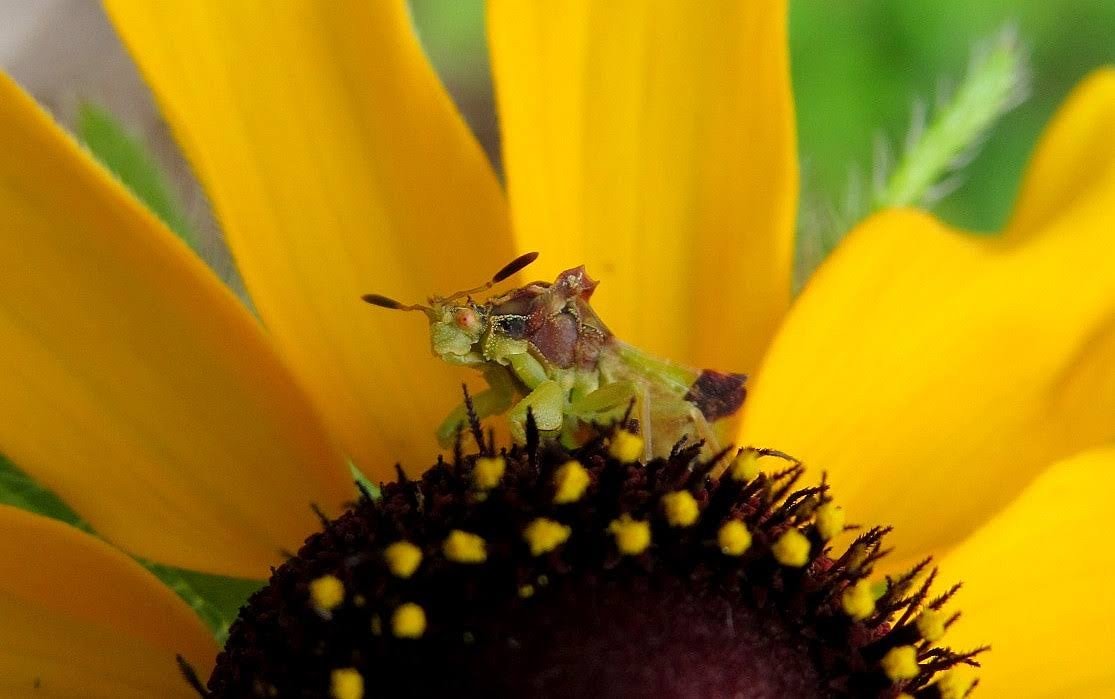A field of goldenrod in autumn, all abloom and aglow in the angled sunshine, might seem a perfect idyll for pollinators.
Wandering from flower to flower, stopping here and there for a sip of nectar or a load of pollen…it really is quite the life for a late-season butterfly or bee. But the fragrant welcoming sea of yellow blossoms also obscures a mortal threat, something as terrifying and monstrous as something out of a Hitchcock movie or a blood-chilling creature feature.
Unseen and deadly, ambush bugs are waiting. And they are everywhere.
There are two species of ambush bugs in our region, Phymata pensylvanica and Phymata americana, which are almost indistinguishable from each other except for some small details of shape. With their fearsomely thickened and hooked forelimbs, plated exoskeletons, red compound eyes, and knobbed antennae, our local ambush bugs really do look like little monsters, kind of a cross between a praying mantis and Shrek.
Males are small (about 3/8” long) and mostly black on the upper side, while females are larger (up to 1/2” long) with yellow-green and brown bands. Scientists believe that ambush bugs can choose flowers for an optimal camouflage match, and also even change their colors to blend in wherever they land. Their small size and cryptic coloration, combined with the ability to remain absolutely motionless, makes ambush bugs very difficult to spot as they lie in wait for prey. They prefer flowers with very small blossoms, such as goldenrods and milkweeds, but will go anywhere that pollinators frequent.
They take insects of all shapes and sizes, from tiny sweat bees and flies to yellowjackets, bumble bees, and butterflies. Ambush bugs can capture and consume prey up to ten times their size. Ambush bugs wait until their unwitting targets come within reach, and then grab the prey with those hooked forelegs. The ambush bugs use their tubular mouthparts to inject both paralyzing poison and digestive enzymes into the prey, immediately silencing any struggle and then liquefying the insides and allowing for ruthlessly efficient consumption, like sipping a cocktail through a straw.
Ambush bugs belong to the taxonomic family Reduviidae (assassin bugs), within the order Heteroptera (true bugs). There are over 100 species of ambush bugs in the world. Though common throughout the continent, ambush bugs have been a taxonomic mystery in North America, as scientists are still sorting out their distribution and phylogeny. While 17 species and 11 subspecies have been documented, scientists are still finding undescribed species and noting inconsistencies and errors in past species descriptions and identification of museum specimens. A team at the University of California at Riverside is now pursuing a full taxonomic revision of Phymata in North America, supported by molecular analysis.
Ambush bugs emerge in our region in July and remain present throughout the goldenrod blooming season, into October. Once you get accustomed to looking for ambush bugs, you might well start to find them practically anywhere there are flowers and pollinators. Ambush bugs are often found in pairs, with the male riding on the female’s back, lurking and feeding together. You might also find ambush bugs in actual copulation, side by side with the undersides of their abdomens twisted to face each other. Ambush bugs in our region have one generation per year, as eggs are laid in the fall and hatch during the next summer.
Perhaps a bit like a successful human couple, male and female ambush bugs strengthen their pair bond not merely by spending time together, but also by sound communication. They produce vibrations by stridulation (rubbing together) of parts of the thorax. Remarkably, ambush bugs also apparently produce sounds to attract prey. They are capable even of mimicking sounds that they hear, all the better to draw the interest of other insects that communicate with each other through specific acoustic signals. Slovenian entomologist Matija Gogala has documented how one species of ambush bug (Phymata crassipes) can actually “converse” with a person, responding to sounds and even matching the duration of spoken syllables and whistles!
And so, with a bit of patient and attentive searching, you might not only start to see ambush bugs all around but also come to admire them as something much more than a predator and antagonist. Yes, you could say they are monsters, but like Shrek and Godzilla, they are singularly fun to watch and even to root for.


